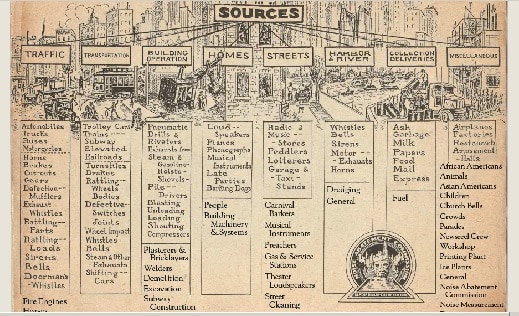A city is a noisy place. The Canadian Hearing Society in … Canada… (bet you couldn’t guess that one?!) has some hearing loss prevention promotional material that says that “noise levels are doubling every decade”. While this is a story that sounds alarmist and is sure to grab attention, there are some data to support it. Noise levels do change very gradually over time; a new, noisier type of municipal bus is introduced, the local highway or interstate has “temporary” construction, a stop sign is installed in a semi-residential area that forces trucks to stop, using their noisy air breaks, and then to start up again with the roar of their diesel engine.
I think what the Canadian Hearing Society was correctly pointing out is that in the past decade the overall noise level may have increased by 3 dB. And while 3 dB does not sound like a large change, and may not even have been noticeable since the change is so slow and gradual, it is a doubling of the energy.
Noise is never homogenous and this is certainly the case when you are outdoors. Even in a well-controlled sound enclosure such as an anechoic room used for acoustic research, engineers and researchers take great pains to ensure that precisely the exact desired noise level occurs at exactly the right point in space. When we add to the equation reflections from buildings, cars, streets, and even people, it’s enough to drive anyone who is interested in measuring the “exact” sound level crazy.
I went out to the front of the office building where my clinic is, and stood there with a sound level meter; the numbers on the screen bounced around from a low of 58 dBA to a high of 92 dBA. Even when the stop light was red and the cars were not moving, the numbers on the screen bounced around within a range of about 5-8 dB. If someone wanted to pay me a lot of money to get the “exact” noise level, I would give them a number, take the money (cash and not a cheque), and then as I was quickly running away, I would need to add, that the “range” was really + or – 5 dB, and that I could only guarantee that the noise level was at a certain specified location and time when the stop light was red.
In short (or is it too late?), it is rather difficult to say precisely what the sound level really is on a city street or residential neighborhood. Variability in the measurement is the rule rather than the exception.
Now we come to municipal noise regulations (or even occupational noise regulations) and as clear as it could possibly say, a number pops up and its says that noise (or music) should not exceed this exact number. I wonder if it means “peak” level or some form of “average” level? And what if the measurement exceeds this level only 10% of the time? I wonder if our city officials are trying to impose a black and white situation on one that is inherently gray?
The most recent city ordinances that have hit the public media in the last several years have been related to the Bourbon Street area of New Orleans, but this certainly isn’t the first. New York City was trying to tackle this problem in the 1930s. The first thing that the New York officials tried to do is to get a handle on the numerous sources of noise, and the figure below shows a rather good overview.

City of New York noise sources (circa 1930)
The figure is adapted from the New York city archives. The jpeg is of low resolution but with a bit of effort, bi-focal lenses, or a glass (or two) of wine, the words may become clearer. For the time period it represents, the figure is a remarkably thorough overview of the sources of residential noise. And though this was made during the Great Ddepression, noise levels appear to be independent of the economic woes of the time.
Categories of street noise, transportation, building maintenance, homes, streets, harbor and river, collection and deliveries, and, of course, miscellaneous are all included. These undoubtedly had something to do with the frequency and nature of complaints. Visibly absent are airplanes and loud music, but those would come later! Through the years, some of these noise sources have gone away (e.g., street car and train switches), while others have increased. And despite this being almost 100 years old many of these same city noise sources are with us today.
I am not sure that there is one solution or even one philosophy. I know that many advocate a rigid control of noise sources in order to ensure that it doesn’t exceed certain levels, while others advocate an educated stance in which the public would become sophisticated consumers aware of the dangers of overexposure to noise, including music.
Noise is insidious and there is really not any one-to-one correspondence between the actual noise sound level and how “annoying” it can be; music being played in a public space can be invigorating for many, and equally distasteful for others.
This is a blog where feedback is certainly requested and will be posted as the comments come in.






